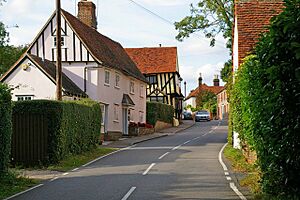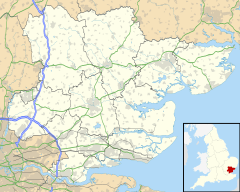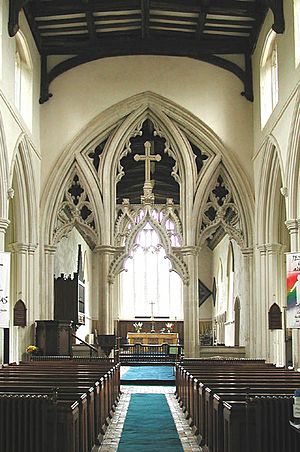Stebbing facts for kids
Quick facts for kids Stebbing |
|
|---|---|
 Stebbing High Street |
|
| Population | 1,300 (2011) |
| OS grid reference | TL677203 |
| District |
|
| Shire county | |
| Region | |
| Country | England |
| Sovereign state | United Kingdom |
| Post town | Dunmow |
| Postcode district | CM6 |
| Dialling code | 01371 |
| Police | Essex |
| Fire | Essex |
| Ambulance | East of England |
| EU Parliament | East of England |
| UK Parliament |
|
Stebbing is a small village located in the northern part of Essex, England. It's found north of an old Roman road called Stane Street. Stebbing is about 6 miles from the closest train station in Braintree and 8 miles from London Stansted Airport. In 2011, about 1,300 people lived here. The village has a pub and a place to play bowling.
Contents
History of Stebbing Village
Stebbing is mentioned in a very old book called the Domesday Book. This book was made in 1086 to record who owned land in England. It says that a person named Henry de Ferrers owned Stebbing.
Just half a mile northwest of the church, there's a place called The Mount. This is a moated earthwork, which means it's an old mound of earth surrounded by a ditch filled with water. It's believed to be what's left of a medieval castle from long ago.
In the late 1200s, the ownership of Stebbing briefly went to a Scottish noble family called Douglas. This happened when William the Hardy, Lord of Douglas married Eleanor de Lovaine. Eleanor was the widow of William de Ferrers of Groby. She was under the care of King Edward I of England. The king had set aside her late husband's lands, including Stebbing, for her to use if she remarried.
However, William Douglas took Eleanor and married her around 1288 without the king's full permission. William Douglas was an important figure on the Scottish side during the First Scottish War of Independence. Because of this, his English lands were taken away by 1298. He later died while being held in the Tower of London. His son, Hugh Douglas, had been captured earlier in Stebbing in 1296 by the Sheriff of Essex.
The Village Church
The church in Stebbing is called St Mary the Virgin. It's a very old and important building, listed as Grade I. Most of the church was built around 1360.
One very special part of the church is its stone rood screen. This is a decorative wall or screen that separates the main part of the church from the altar area. There are only three of these stone screens left in all of Europe! The other two are in Great Bardfield (also in Essex) and in Trondheim, Norway.
The first time this church was written about was in 1377. It mentioned that Henry de Ferrers was "said to have been born in the Abbey of Tilty and baptised in the church of St. Mary the Virgin, Stebbing."
During some work inside the church a few years ago, parts of an even older building's foundations were found. They also found old coins from the time of King Henry II, who ruled from 1154 to 1189. In 2010, during more restoration work, people discovered pieces of medieval wall paintings. These paintings would have been very colorful and told stories from the Bible.
How Stebbing is Governed
Stebbing is part of an electoral ward (a local voting area) that has the same name. In 2011, this ward had a population of 1,560 people. This means that these people vote for their local representatives who help run the area.
Famous Residents
The writer Henry De Vere Stacpoole lived in Stebbing for more than ten years with his wife, Margaret. During his time in the village, he also worked as a justice of the peace. A justice of the peace is a local official who helps with minor legal matters and keeps the peace. In 1922, Henry and Margaret moved away to the Isle of Wight.
See also
 In Spanish: Stebbing (Essex) para niños
In Spanish: Stebbing (Essex) para niños



